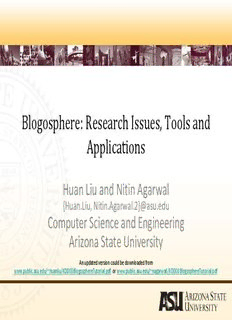
Blogosphere: Research Issues, Tools and Applications PDF
Preview Blogosphere: Research Issues, Tools and Applications
Blogosphere: Research Issues, Tools and Huan Liu and Nitin Agarwal Applications {Huan.Liu, Nitin.Agarwal.2}@asu.edu Computer Science and Engineering Arizona State University An updated version could be downloaded from www.public.asu.edu/~huanliu/KDD08BlogosphereTutorial.pdf or www.public.asu.edu/~nagarwa6/KDD08BlogosphereTutorial.pdf Acknowledgments • We would like to express our sincere thanks to Magdiel Oliveras Galan, John J. Salerno, Shankar Subramanya, Sanjay Sundarajan,Lei Tang, Philip S. Yu , and Alan Zheng Zhao for collaboration, discussion, and valuable comments. • This work is, in part, sponsored by AFOSR and ONR grants in 2008. • This agreement covers the use of all slides of this tutorial. – You may use these slides freely for teaching if you send us an email stating the university name and class/course number in advance, and cite this tutorial. – If you wish to use these slides in any other ways, please contact (or email) us. The ppt version contains notes with additional information such as various sources in addition to References. Outline Background: Web 2.0 and Social Networks • Blogosphere: Definition, Types, and Comparison • Blogosphere Research Issues • Tools and APIs • Data Collection • Measures, Models, and Methods • Performance, Evaluation, and Metrics • Case Studies • References • WEB 2.0 AND SOCIAL NETWORKS Web vs. Web 2.0 Characteristics of Web 2.0 Rich Internet Applications • User generated contents • User enriched contents • User developed widgets • Collaborative environment: Participatory Web, Citizen • journalism Thus, it leverages the power of the Long Tail with user • generated data as the driving force More of a paradigm shift than a technology shift • Web 2.0 Services (examples) • Blogs – Blogspot – Wordpress • Wikis – Wikipedia – Wikiversity • Social Networking Sites – Facebook – Myspace – Orkut • Digital media sharing websites – Youtube – Flickr • Social Tagging – Del.icio.us • Others – Twitter – Yelp Top 20 Most Visited Websites Internet traffic report by Alexa on July 29th 2008 • 1 Yahoo! 11 Orkut 2 Google 12 RapidShare 3 YouTube 13 Baidu.com 4 Windows Live 14 Microsoft Corporation 5 Microsoft Network 15 Google India 6 Myspace 16 Google Germany 7 Wikipedia 17 QQ.Com 8 Facebook 18 EBay 9 Blogger 19 Hi5 10 Yahoo! Japan 20 Google France 40% of the top 20 websites are Web 2.0 sites • Social Networks A social structure made of nodes (individuals or • organizations) that are related to each other by various interdependencies like friendship, kinship, like, ... Graphical representation • – Nodes = members – Edges = relationships Social Networks
Description: